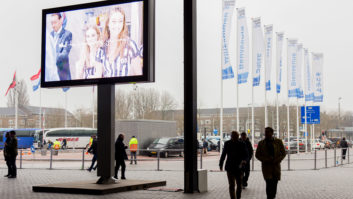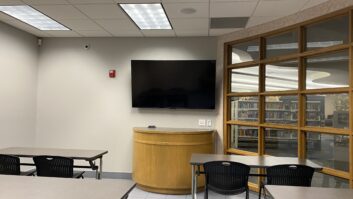The struggles between the interests of architects and AV professionals are well documented. But what can be done to improve the situation? And are architects the only guilty party? Paddy Baker reports
You probably know the clichés about clashes between architecture and technology professionals. The technologist wants to put in the best equipment to fulfil the function of the space, with the best audio, video or lighting that the budget will allow. The architect, however, is more concerned with the overall look of the space, and doesn’t want any boxes on show that carve up his nice clean lines; and so arguments ensue. In another case, the integrator is only called in when the cabling has already been run, and ends up running unsightly trunking over the walls for the Cat5 cable.
Unfortunately, these are clichés that have a degree of truth in them. Everyone contacted for this article recognised the scenario of compromised installations due to technology requirements being considered either too late, or functional considerations being overruled.
After the event
Toby Wise, managing director of integrator Snelling Business Systems, comments: “It’s very common for us to be brought in after the event and find that there is only a computer data network, or standard office lighting. In addition, we may find we’re working in new buildings with hard surfaces – glass, steel – that don’t make things easy for us.”
He continues: “The architect may be looking to create something new and contemporary that moves the game forward – so he may have an agenda running alongside that of the client. Or the architect may simply not know how to plan for AV.”
AV consultant Graham Naylor-Smith, associate director at Arup Communications, while stressing that this does not apply across the board, says: “There are times when architects don’t understand how spaces are going to be used before they start designing them. What that often means, particularly when an AV consultant hasn’t been involved, is that an AV contractor will only turn up when the space has already been designed – and at that point it may be too late.”
Blair Parkin is managing director of consultancy Visual Acuity, which works in the areas of AV, interactive media and IT. He says he founded his business because “I’d spent years on the manufacturer and integrator side turning up at auditoriums where a $100,000 projector had been ordered, and finding a pillar in the middle. It’s very easy to blame the architect – I used to do that when I was an integrator – but having done this job for nine years, we’ve learnt that very often it isn’t the architect’s fault.” (More on that later.)
If this is all sounding somewhat anecdotal, some more quantitative findings come from InfoComm’s recent US study Building Automation – Opportunities and Challenges for the Audiovisual Industry. This looked at the relative importance of various systems in the built environment from an architectural perspective.
“MEP (mechanical, electrical, plumbing) is the first system, after the basic mechanical engineering is complete, that an architect is concerned with,” explains Terry Friesenborg, the association’s senior VP of international development.
“Contacts report that it receives roughly 50% of the time, energy, money, and attention during the design stage.”
Subsequently, other low-voltage systems are looked at. “In order of relative importance, voice and data came first, followed by security, AV and finally speciality lighting. Alarm systems tend to be addressed separately,” he says.
Positive steps
So, what positive steps can be taken to improve this situation? One option, clearly, is for project teams to use an AV consultant – but that’s not the only one, as our AV consultants are quick to point out.
“The key is to get someone who can represent the AV side of things onto the design team,” says Naylor-Smith.
“Whoever it is, they should be engaged early – whether that’s an internal person responsible for AV who’s seconded onto the project team, or an AV integrator, or an AV consultant – at the end of the day it doesn’t matter who it is, as long as somebody competent is present.”
Parkin agrees: “It could be an AV consultant, it could be a manufacturer, an integrator – or it could be done by taking advice from a successful similar project.”
Naylor-Smith and Parkin both say that RIBA Stage D, scheme design, is the appropriate stage for this representation to take place. This is where the concept design (Stage C) is fleshed out and budgets are confirmed, and comes before the stage when detailed decisions are taken on matters such as overall appearance.
Jamie Blakemore, UK sales manager at Crestron UK, comments: “We’re always happy when an architect involves us in a project from the outset, as it ensures that AV can be given the priority it deserves. We recognise that the architect can benefit from advice from the product provider. We can work with the systems integrator and architectural practice, and provide insight during the architectural design, equipment evaluation and procurement process, streamlining an audiovisual project to completion on budget and on time.”
It would be nice if that were the end of the story, but it’s not. First, the architect may simply not countenance what the AV representative has in mind. In these cases, can the AV camp bring pressure through the client? “It all comes down to relationships and who’s in charge of what,” says Naylor-Smith. “Sometimes the AV people, even on the client side, may lose out because of the way the project is configured: other people will take the decision that AV is not important to the client’s business.”
Next, when it comes to adding to confusion on projects, manufacturers can’t always be held blameless. For example, Parkin has a warning about product data sheets: “When you use them ‘in anger’ in design, they don’t always tell the truth. That can be either because they’re either designed before the product ships, and based on estimated data, or because they’re designed for ‘specmanship’ – to sell the product against the competition – and rarely give you the correct power, positional or weight information.
“As a group of consultants, we’re completely cynical about manufacturers’ data sheets – that’s probably unfair, but we start with the data sheet and then ask questions. “
Competing aims
And if architects can sometimes think too much about the space and too little about the technology, manufacturers can be guilty of the exact opposite. “We find people specifying things – because the manufacturer’s trying to sell as many square metres as possible – that the user can’t actually see, because they’re too big for the designed space,” he continues. “We see manufacturers’ reps do that all the time. If you’re coming through one space with a low ceiling into a high space, by the time you get to the display you’d have to lie on your back to see the top of it. But they’ve only measured the surface area of the wall it’s going on.”
Another potential source of problems comes from a lack of engineering skill on site. One occurrence encountered by Visual Acuity was at an Athens cultural centre: a wall unexpectedly appeared in the middle of the dome auditorium. “It turned out that the builder didn’t read the drawings properly and brought a wall up from the basement right into the auditorium,” explains Parkin.
“We see spaces not being built right all the time, and the causes are many and varied. In the UK, particularly with public projects, the general contractor is beaten to death on price, so they don’t put engineers on the project to read drawings. This means things get built wrong, it’s too expensive to change, and technologists have to work around the problem.”
Building links
So we’ve established that architects aren’t the sole cause of poor AV installations. However, it’s also the case that reaching out to the architectural community will be of increasing importance as technology becomes increasingly pervasive in the built environment.
Friesenborg points out that InfoComm International became a RIBA Continuing Professional Development (CPD) plan provider in 2008 – providing information in the form of presentations, facility visits and downloadable materials that architects can use to fulfil their professional obligation to develop their knowledge of chosen areas.
“In addition, InfoComm has developed a special website for architects at www.ctsforav.com,” he says. “This site shows the architect the advantages of working with the AV industry sooner rather than later, and why it’s important to be involved with CTS Certified AV professionals. We also provide members with a CTS Tool Kit to help them understand how to leverage their certification with the specifying community in their marketing and sales activities.”
Integrators can also reach out to architects. For instance, Snelling Business Systems has placed advertisements in RIBA publications “to tell architects that there are these things called ‘audiovisual’ and ‘installed audio’ – and that there are things they need to take on board,” says Wise.
Naylor-Smith points out other professional groups that should be targeted. “It would be great to educate architects better – that’s part of the issue,” he says. “But it’s also about the people who are commissioning the projects, and about other professionals such as project managers. They may only be commissioned to project-manage the construction of a building, whereas AV is about how the client conducts his buiness once he is occupying the building.”
Returning to individual project level, he has the following advice to integrators: “Know your technology, and don’t be afraid to say, ‘This isn’t going to work so well, unless you make these changes.’ For instance with HD videoconferencing, you’ll need better lighting than standard to get all the benefit of a good camera. And when the picture looks better, people will expect the sound to be better too – and that may not happen if the room happens to be a box with two sides made of glass.”
There are occasions when, because of the architect’s lead designer role, the integrator simply has to live with a compromised outcome. But, as Naylor-Smith reflects: “When, say, you design a boardroom for a chief executive to do his job – if he can’t successfully videoconference with his Hong Kong office at 7:30 every morning, it’s the AV consultant or contractor who will get the blame, not necessarily the architect!”
Reference lag
Even if architects are aware of the importance of designing with AV in mind, their standard reference sources often do not keep pace with the rate of progress of technology. “Just through publishing cycles, the data could be three years old – and technology is moving at a rate that could mean that the advice given by the book to the designer is out of date,” says Blair Parkin of Visual Acuity. “For instance, there’s a huge problem at the moment with the move to low-energy solid-state lighting: the positioning and powering of fixtures and the fact that they need to be connected to a network have all changed.”
Trade associations can help here, says InfoComm’s Terry Friesenborg, although members’ help is needed too: “InfoComm International has the body of knowledge to provide this information to relevant publications. We have done so in the past… InfoComm published an AV Design Reference Manual in co-operation with BICSI several years ago. We have many courses and publications that can be referenced to update other organisations’ publications. It’s important for our regional members to make our local representatives aware of such needs so we can reach out to organisations to find ways to co-operate.”
www.arup.com
www.crestron.co.uk
www.ctsforav.com
www.infocomm.org
www.snellingbiz.com
www.visual-acuity.com







